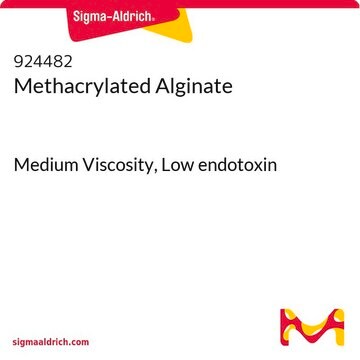Only the aldehyde content is determined by the titration with hydroxylamine. The location of the aldehyde groups is not determined and the image is representative.
Kluczowe dokumenty
923850
Alginate Aldehyde
20% aldehyde content, medium viscosity
Synonim(y):
Aldehyd alginianowy, Utleniony alginian
Wybierz wielkość
1100,00 zł
Wybierz wielkość
About This Item
1100,00 zł
Polecane produkty
Poziom jakości
opis
Degree of functionalization: 15-25%
Formularz
powder
kolor
white to off-white
przydatność
conforms to structure for NMR
temp. przechowywania
2-8°C
ciąg SMILES
CO[C@H]1[C@@H](O)[C@H](O)[C@H](O/C(C=O)=C\C([O-])=O)O[C@@H]1C([O-])=O.OC2[C@H](OC(O)C=O)[C@@H](C([O-])=O)O[C@@H](OC)[C@H]2O
Szukasz podobnych produktów? Odwiedź Przewodnik dotyczący porównywania produktów
Powiązane kategorie
Zastosowanie
Alginian jest powszechnie sieciowany do postaci hydrożelu poprzez sieciowanie jonowe kationami dwuwartościowymi (np. Ca2+). Aby zapobiec degradacji matrycy, alginian może być funkcjonalizowany grupami reaktywnymi, które mogą być sieciowane chemicznie, takimi jak aldehydy.[5] Alginian funkcjonalizowany aldehydami może być stosowany do przygotowania hydrożeli poprzez reakcję z grupami aminowymi, takimi jak żelatyna, poprzez reakcję zasady Schiffa w celu utworzenia chemicznego hydrożelu. Materiał ten może być wykorzystywany w różnych zastosowaniach biomedycznych, takich jak dostarczanie leków, komórek lub biomolekuł do różnych tkanek, gojenie się ran oraz inżynieria tkanki mięśniowej i kostnej. [6]
Kod klasy składowania
11 - Combustible Solids
Klasa zagrożenia wodnego (WGK)
WGK 3
Temperatura zapłonu (°F)
Not applicable
Temperatura zapłonu (°C)
Not applicable
Wybierz jedną z najnowszych wersji:
Certyfikaty analizy (CoA)
Nie widzisz odpowiedniej wersji?
Jeśli potrzebujesz konkretnej wersji, możesz wyszukać konkretny certyfikat według numeru partii lub serii.
Masz już ten produkt?
Dokumenty związane z niedawno zakupionymi produktami zostały zamieszczone w Bibliotece dokumentów.
-
Is the alginate aldehyde terminated, as described in the linear formula, with only 20% of the chains functionalized? Or is the backbone of the chain functionalized with aldehyde with 20% of the monomers containing aldehyde groups?
1 answer-
Helpful?
-
Active Filters
Nasz zespół naukowców ma doświadczenie we wszystkich obszarach badań, w tym w naukach przyrodniczych, materiałoznawstwie, syntezie chemicznej, chromatografii, analityce i wielu innych dziedzinach.
Skontaktuj się z zespołem ds. pomocy technicznej








